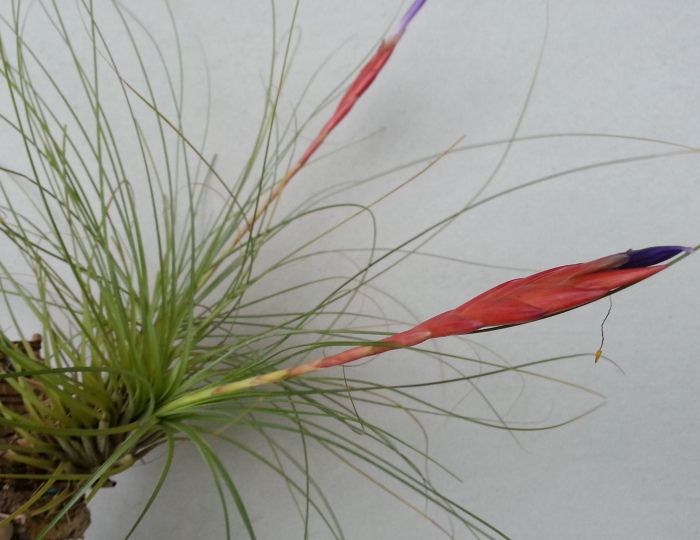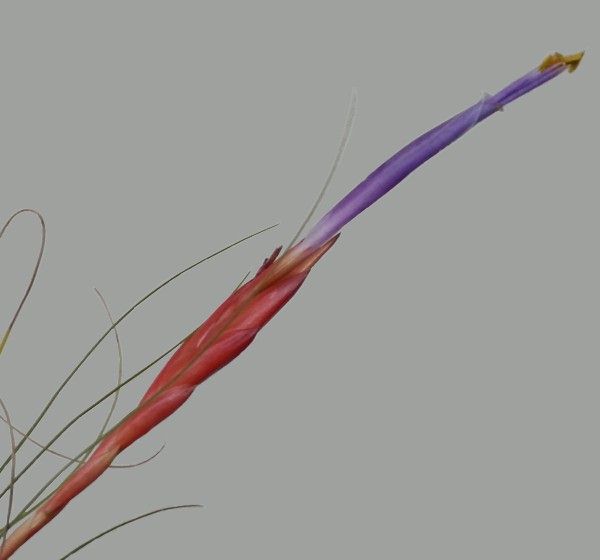

PLANT - Growing in dense clumps, with short, to 8cm long stolons covered by the sheaths of the basal leaves, flowering to 45cm high
LEAVES - Numerous, the bottom forming a lax pseudobulb.
LEAF SHEATH - Easily seen, to 1cm long, 1cm wide, both sides dark brown lepidote, edges strongly bent.
LEAF BLADE - Near the sheath 5mm wide, strongly canaliculate and brown scaled, narrowing to filiform, 1mm wide, to 35cm long, green both sides appressed lepidote.
SCAPE - Erect to ascending, thin, 15-25cm long, about 2mm diameter.
SCAPE BRACTS - The bottom ones leaflike, the upper with longer, greenish red nerved sheath and very short blade, longer than the internodes, gradually flowing over to the floral bracts.
INFLORESCENCE- Single spike, exceeding the leaves. Spike complanate, 4-10cm long, 1-1.5cm wide, 3-8 flowered. Rhachis not visible.
FLORAL BRACT - Erect, imbricate, lancelike-oval, acuminate, subcarinate, to 2.7cm long, 1.2cm wide, much longer than the sepals, membranous, red nerved, tip scattered lepidote.
SEPALS - Lancelike-acuminate, to 2.5cm long, 5mm wide, scattered lepidote, the posterior keeled and joined for 5-6mm.
PETALS - Thin-ligulate, erect, to 5cm long, violet-blue.
STAMENS - A little overhanging. Style much longer at post-anthesis.
HOLOTYPE R Ehlers EM 8285 ( March 1982) HEID
HABITAT- Between Oaxaca and Porto Escondido, in high passes, 1800m, epiphytically on pine trees, State Oaxaca, South MEXICO.
Differs from T. chaetophylla in
1 - Stolon 6-8cm long.
2 - Leaf sheath making a lax pseudobulb.
3 - Upper stem bracts tipped, not with filiform blade.
4 - Inflorescence exceeds the leaf.
5 - Posterior sepals joined for 5-6mm, carinate and weakly lepidote.
6 - Stamen and style overhanging.
T. nolleriana was collected many times, by Mr. Lautner, Gottingen (83/84) between Poschutla and Oaxaca, 1300 m, and cultivated in the Heidelberg botanical garden under the number B.G.H. 64 266; also by Rauh between Puerto Angel and Oaxaca near 800 m, (Rauh 52 564).
T. nolleriana resembles prefloral T. chaetophylla likewise from Mexico, however, postfloral it differs but is similar to T. tricolor Schlechtendal & Chamisso and T. punctulata Schlechtendal & Chamisso with its offsets at the base; and differs from T. chaetophylla whose stamens and style are enclosed (fig. 19a, also Fig. 237, p 766 in Smith and Downs, Tillandsioideae, in Flora Neotropica, Vol. 14/2). The flowers open (in cultivation) in the early afternoon and remain open for the next 2-3 days; with T. nolleriana the flowers open in the morning and are withered on the next day.
It is similar to T. ortgieiana E. Morr. but T. nolleriana differs in following characteristics:
Leaves green, only appressed lepidote. Sheaths broad. Spike much longer; floral bracts exceeding the sepals, which are very short connate and scattered lepidote.